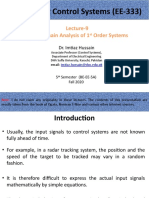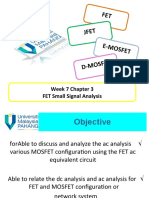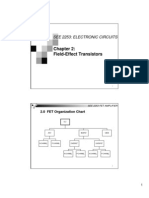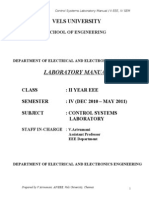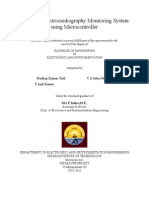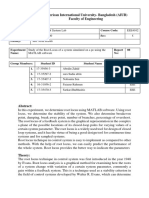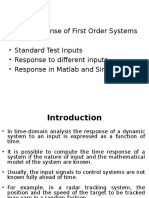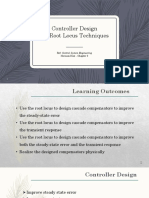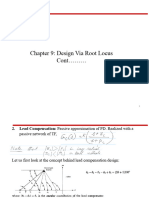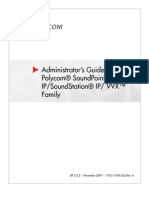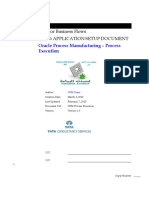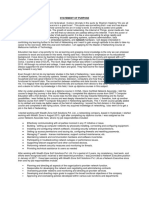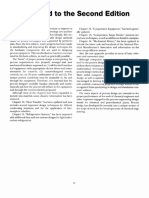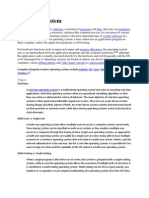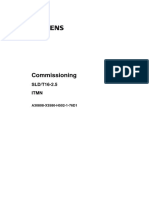AUTOMATIC CONTROL
THIRD POWER Prepared by Dr. Helmy El-Zoghby 2013
3/9/2013
Design of compensators using root locus diagram
3/9/2013
�A compensator (filter or controller) is a circuit which added to the control system to improve the system performance.
Different types of controllers
1. Two Position Controller 2. Proportional Controller 3. Integral Controller 4. Differential Controller 5. PI Controller 6. PD Controller 7. PID-Controller 8.Lead compensator 9.Lag compensator 10.Lag-lead compensator 11.Intelligent compensators (fuzzy , neural , genetic , .)
3/9/2013
Benefits of compensators
Lead compensator (as PD-controller) is used to: - improve transient response - improve stability Lag compensator ( as PI-controller) is used to: - reduce or eliminate steady-state error Lag- Lead compensator ( as PID-controller) - used to improve all issues.
3/9/2013
�Note:
For a closed loop system:
By placing the closed-loop poles at the desired location -if the new closed-loop poles lies on the old root locus , then k is tuned or using P-controller (amplifier). -if the new closed-loop poles not lies on the old root locus , then reshape the root locus by adding poles/zeros (compensator) to system.
3/9/2013 5
Effect of adding poles on control system response
3/9/2013
�Effect of adding zeros on control system response
3/9/2013
Lag and lead compensators concept
The controller transfer function
(s) =
(s + z c ) (s + p c )
c
3/9/2013
�Lead compensator
3/9/2013
Lag compensator
3/9/2013
10
�Electronic circuit of lead or lag compensator
G c (s) =
v v
(s)
(s) i
R C R C
4 3
(s +
1 2
. (s +
R C
1
)
1
= )
(s + z c ) (s + p c )
R C
2
For lead R1C1> R2C2 For lag R1C1< R2C2
3/9/2013 11
Lead compensator design example
Radar tracking system
3/9/2013
12
�draw the uncompensated system root locus and find the damping ratio and natural frequency at k=4 design a suitable compensator using three different methods to rise the natural frequency to 4 rad/sec at the same damping ratio draw the compensated root locus draw the designed controller electronic circuit check the steady state error after adding the controller draw the transient response before and after compensation.
3/9/2013
13
solution
For the uncompensated system
K = p2 p2 = 4 then
= 2 , = 60
and = cos( ) = 0 . 5
3/9/2013
14
�Angle of deficiency is:
= 180 o + of all zeros of all poles = 180 + 0 (120 + 90) = 180 210 = 30 0
3/9/2013
15
1-Design of compensator using minimum steadystate error method
3/9/2013
16
�Selection of the controller pole and zero
3/9/2013
17
The compensated system T.F is :
K c = p1 p2 p c / 4 * zc = 4.68
3/9/2013
18
�Steady-state error before and after compensation at unit ramp input Before compensation
k v = lim sG ( s ) H ( s )
s =0
= lim s.
4 s ( s + 2)
s=0
=2
ss
= 0.5 = 50%
v
After compensation
kv
new
= lim sGc ( s )G ( s ) H ( s )
s =0
4.68( s + 2.9) 4 = lim s. ( s + 5.4) s ( s + 2) 1 new ess = new = 0.2 = 20%
s=0
= 5.02
3/9/2013
19
Note : If the input is unit step : Before compensation
k e
= lim =
ss
1+ k
4 = s ( s + 2) s=0 1 = 0%
p
After compensation
k e
new p
= lim =
new
ss
1+k
4.68(s + 2.9) 4 (s + 5.4) s(s + 2) 1 = 0% new
p
s =0
3/9/2013
20
�Root locus before and after compensation
3/9/2013
21
Compensator electronic circuit
( s + 2 .9 ) ( s ) = 4 . 68 = ( s + 5 .4 )
R C R C
4 3
(s +
1 2
. (s +
R C
1
)
1
R C
2
)
2
4 . 68 take
R C R C
4 3 3
1 2
, take
= 10 uf
= 10 k
then
= 46 . 8 k ,
= 34 . 5 k ,
= 18 . 5 k
22
3/9/2013
�2-Design of compensator using zero-pole cancellation method
Since the Angle of deficiency =300 and
(s) =
(s + z c ) (s + p c )
-Select the controller zero equal to the nearest pole of the system to the desired point to cancel this pole -Find the controller pole from angle condition -Find kc from magnitude condition
3/9/2013
23
Take Zc=2 and from angle condition Pc=4 From magnitude condition
jw p
30
K c = p1 p c / 4 = 4 * 4/4 = 4
The controller T.F become :
G
c
(s) =
(s + 2 ) (s + z c ) = 4 (s + p c ) (s + 4 )
x
-4 -2
x o
-1
x
0
Steady-state error before design
k v = lim s. 4 s ( s + 2)
s =0
= 2, ess =
= 0.5 = 50 %
v
Scale 1:2
Steady-state error after design
kv
new
= lim s.
4( s + 2 ) 4 ( s + 4) s ( s + 2)
s =0
= 4, e ss
new
new v
= 0.25 = 25 %
24
3/9/2013
�Design of compensator using PD-controller
PD-controller block diagram
PD-controller electronic circuit
k k
= RC =
R R
2 1
PD-controller transfer function
T .F =
3/9/2013
s =
(s +
k k
p d
) =
(s +
)
25
Since the Angle of deficiency =300
T .F =
s =
(s +
k k
p d
) =
(s +
-the angle of controller zero must equal to 300 -draw a line of 300 with real axis from point (p) -Find the controller zero from angle condition -Find kd from magnitude condition
3/9/2013
26
�jw p
Zc=7.8
30
x
-2
-1
x
0
Scale 1:2
Compensated and uncompensated root locus
3/9/2013
27
From angle condition
=
k k
p d
= 7 .8
From magnitude condition
PD-controller electronic circuit
= p1
p 2 / 4 z c = 4 * 3.5/4 * 6.3 = 0.6 = R * C then R = 60 k
2
take C = 10uf then takeR
k
1
R R = 1 k then R
p
= 4 .6 =
= 4 .6 k
3/9/2013
28
�The controller T.F become :
T .F =
s = 4 .6 + 0 .6 s
Steady-state error before design
k v = lim s. 4 s ( s + 2)
s =0
= 2, ess =
= 0.5 = 50 %
v
Steady-state error after design
kv
new
= lim s.(4.6 + 0.6s).
4 s(s + 2)
s =0
= 9.2, ess
new
new v
= 0.109 = 10.9%
3/9/2013
29
Using zero-pole cancellation method try to solve this problem and simulate by matlab
A-If it required to design a lead controller to get overshoot=2% and peak time equal 1 sec
Check these values by calculations Lead angle =96 degree , wd=3.14 , wn=5, zeta=.779 ,beta= 38.
1.4
1.2
res po nc e
0.8
0.6
0.4
0.2
3/9/2013
5 Time
10
30
�B-at 1 sec peak time and 10% over shoot Check these values by calculations zeta=.57 , wd=3.14 , wn=3.89 , lead angle =35, beta=55
1.4
1.2
res ponse
0.8
0.6
0.4
0.2
5 Time
10
3/9/2013
31
Proportional-Integral controller (lag compensator)
Time output equation is :
p(t ) = k p e(t ) + k i e(t )dt
where Kp is the proportional constant and Ki is the integral constant.
The block diagram of the PI controller
The PI - controller electronic circuit.
32
�Design of lag compensator (PI-controller)
The PI-controller transfer function is :
T .F =
k
s
s + s
s + =
k (
p
k k
s
i p
)= k
s +
c
s +
z p
i p
c c
x
zc
pc
The pole of the controller at s=0 The zero of the controller at
s =
k k
3/9/2013
33
PI-controller design steps
The pole of the controller at s=0 The zero of the controller at s=-ki/kp is obtained from angle condition The controller gain constant kp is obtained from magnitude condition
Example
For the following open loop transfer function design a controller to satisfy 0.8 damping ratio , natural frequency of 5 rad/sec , and elimination of steady-state error
G (s)H (s) =
3/9/2013
1 ( s + 3 )( s + 7 )
34
= 5, = cos 1 ( ) = cos 1 ( 0 .8) = 37 0
The steady-state error is zero , PI controller is used
=
T .F
k
(
k
s
s + s
k
s +
s + =
k k
s
i p
)= k
s +
z p
c c
Angle of deficiency is:
= 180
o
of
all zeros
of
all poles
= 180 + 0 (108 + 45 ) = 27
Lag compensator is required
3/9/2013 35
From angle condition
Z
From magnitude condition
k k
i p
= 2 .5
Kc = then
= p 1 p 2 p c / 1 * z c = 20
= 2 . 5 * k p = 50
The controller transfer function is
s +
G
3/9/2013
(s) =
k (
p
k k
s
i p
)=
20
s + 2 .5 s
36
�PI-controller electronic circuit
k R
p
R R R
2 1
= 20
take
1
= 1k
2
then
= 20 k
1 RC R
= 50
take C = 10 uf then = 2k
37
3/9/2013
Jw p
Wn=5 27 45 X -7 108 37 X O -3 Zc=-2.5 X Pc=0 Re
Scale 1:1
3/9/2013
38
�Thank You & Any Questions?
3/9/2013
39

